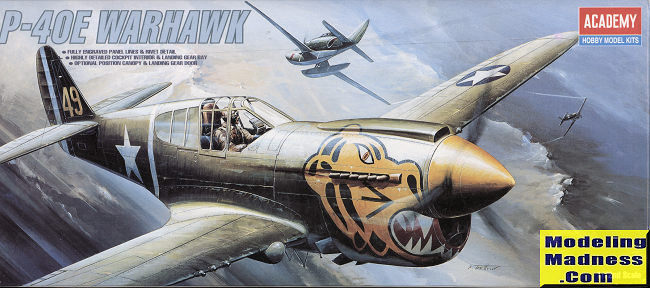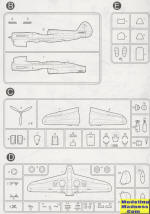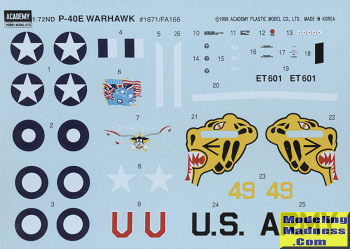
| KIT #: | 1671 |
| PRICE: | $10-15.00 |
| DECALS: | Three options |
| REVIEWER: | Scott Van Aken |
| NOTES: | 1999 edition |

| HISTORY |
The P-40 was a development of the P-36 that utilized a liquid-cooled V-12 engine to provide a higher speed than what was available with the radial engine P-36. In that means it was successful and when the US entered WWII, it was the most widely used aircraft in the USAAC. It was not the 'dog' that many consider it to be. At low and medium altitude it was able to hold its own against German and Italian aircraft. This was proven in North Africa while in the hands of the RAF and Commonwealth air forces prior to America's entry into the war. It was also useful in the SWPA and CBI where its fairly long range and rugged construction was effective against Japanese rifle calibre machine guns.
The Warhawk/Kittyhawk really made its mark in the ground attack role. Despite its liquid cooled engine, which made it susceptible to ground fire, the P-40 was widely used in this role in areas with limited enemy air interference until the end of the war.
| THE KIT |
 This
is not the newest offering of the E model P-40 in 1/72 nor the oldest.
However, it is considered to be a good one. It
does surpass the Hasegawa kit in terms of interior detail though it is
obviously based on it to some extent. But then, it is also that there are
only so many ways to model a specific subject so there is that.
This
is not the newest offering of the E model P-40 in 1/72 nor the oldest.
However, it is considered to be a good one. It
does surpass the Hasegawa kit in terms of interior detail though it is
obviously based on it to some extent. But then, it is also that there are
only so many ways to model a specific subject so there is that.
Academy has done at least two other variations on the later P-40 and that shows with parts on the sprues for the other versions. What makes this the E model are the proper fuselage halves. There is sidewall detail that is fairly nicely done. In addition, the Academy kit includes rudder pedals and a flap handle missing in the Hasegawa kit. It also has separate exhaust that can be added after painting.
Hasegawa missed the radio mast that Academy includes. Radiator intake, landing gear, cowl flap, bomb/drop tank, and the way the prop is attached are all identical to the Hasegawa kit. What is different is that there is an insert behind the pilot's seat for either the quarter windows or for the N model's better rear view section. The framework on the clear bits is also better pronounced, which will really help in masking.
 Instructions
are well done with generic and FS color information. Three nice options are
provided. The box art plane is a very popular scheme from the 343rd Fighter
Group in the Aleutians with the tiger face. This plane is OD over neutral
grey. The next is in a dark green and sand over neutral grey scheme with the
9th FS/49th FG in New Guinea during 1942. Finally an RAAF plane in dark
green/dark earth over sky with 77 squadron, also in New Guinea during 1942.
Decals are nicely printed, but there are aftermarket if you are so inclined.
Instructions
are well done with generic and FS color information. Three nice options are
provided. The box art plane is a very popular scheme from the 343rd Fighter
Group in the Aleutians with the tiger face. This plane is OD over neutral
grey. The next is in a dark green and sand over neutral grey scheme with the
9th FS/49th FG in New Guinea during 1942. Finally an RAAF plane in dark
green/dark earth over sky with 77 squadron, also in New Guinea during 1942.
Decals are nicely printed, but there are aftermarket if you are so inclined.
| CONCLUSIONS |
This kit has several things going for it. One is that it is inexpensive. Two is that it is readily available. Third is that it makes into a very nice model which is fairly easy to build for the beginners or those just wanting a nice kit with no real hassles.
June 2020
Copyright ModelingMadness.com. All rights reserved.
If you would like your product reviewed fairly and fairly quickly, please contact the editor or see other details in the Note to Contributors.
Back to the Main Page Back to the Review Index Page Back to the Previews Index Page